Ravinia favorite Misha Dichter’s double life revealed: The pianist’s a serious cartoonist
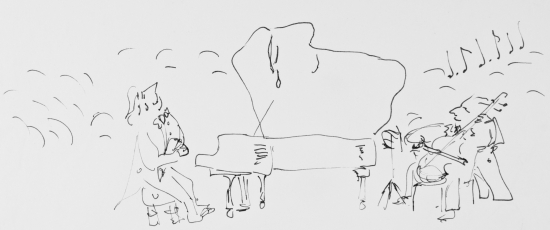 Report: Pianist Misha Dichter, who celebrates his 45th consecutive season with the Ravinia Festival on July 29, shares his passion for sketching in a new e-book.
Report: Pianist Misha Dichter, who celebrates his 45th consecutive season with the Ravinia Festival on July 29, shares his passion for sketching in a new e-book.
By Nancy Malitz
Few relationships between festival and artist have been as enduring as that of the Ravinia Festival and pianist Misha Dichter, who is celebrating his 45th consecutive season with the Ravinia Festival this summer.
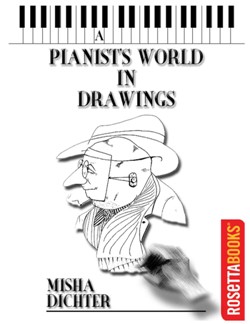 Dichter’s international career was launched after he won the silver medal in the 1966 Tchaikovsky Competition in Moscow while still a conservatory student of Rosina Lhevinne at Juilliard. (See him as budding pupil here.) He made his Ravinia debut in 1968 with conductor Josef Krips and the Chicago Symphony Orchestra, and he has returned every year since then to perform concertos or chamber music.
Dichter’s international career was launched after he won the silver medal in the 1966 Tchaikovsky Competition in Moscow while still a conservatory student of Rosina Lhevinne at Juilliard. (See him as budding pupil here.) He made his Ravinia debut in 1968 with conductor Josef Krips and the Chicago Symphony Orchestra, and he has returned every year since then to perform concertos or chamber music.
So Chicago knows Misha Dichter pretty well. Yet it might come as a surprise that throughout his long career, Dichter has been a secret and habitual doodler, a sketching chronicler of pretty much every aspect of his life as a traveling musician.
And although his sketches do reflect sublime moments such as that magical interlude in the Brahms Second Piano Concerto for cello solo — pictured above — most of Dichter’s images are pointedly droll.
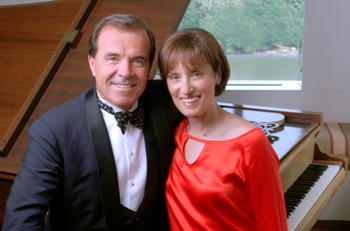 “Sketching has been an outlet in the best possible sense of the word,” said Dichter on the telephone from the Aspen Music Festival, where he and his wife, Cipa Dichter, were about to perform a close variant of the duo-piano recital they will play at Ravinia on Sunday, July 29.
“Sketching has been an outlet in the best possible sense of the word,” said Dichter on the telephone from the Aspen Music Festival, where he and his wife, Cipa Dichter, were about to perform a close variant of the duo-piano recital they will play at Ravinia on Sunday, July 29.
“For the longest time, nobody knew about the drawings except us,” said Cipa. The couple stashed them in drawers throughout their New York apartment and shared them only occasionally with close friends. “Over time they became a sort of diary of my life on the road,” Misha explains. “When things didn’t go according to plan, instead of just getting annoyed I would let it all out in a drawing.”
 Now a selection of his favorites have been compiled into an e-book, “A Pianist’s World in Drawings,” released earlier this month by RosettaBooks.
Now a selection of his favorites have been compiled into an e-book, “A Pianist’s World in Drawings,” released earlier this month by RosettaBooks.
Thus Dichter has captured: Brazen pirating in a recital hall. A conductor too carried away for eye contact. An Aspen Festival wind section knocked silly in the high altitude. And a circumstance one sees often enough at Ravinia — the drenched and windblown audience, doggedly hanging on.
Dichter has been an annual visitor at Aspen for almost as long as Ravinia — since 1974 — and there are several sketches that capture the wonderfully laid-back atmosphere of that place, where virtuosos casually view intermission as a chance for ten minutes of tennis.
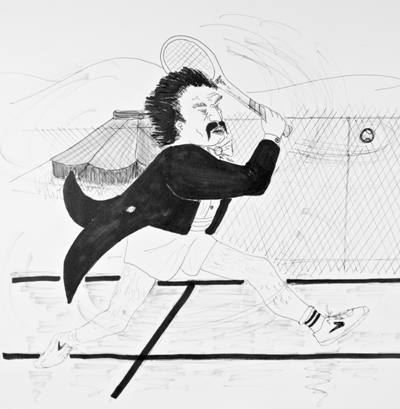 Dichter conducts a master class at Aspen every summer and says the level “continues to be astounding.”
Dichter conducts a master class at Aspen every summer and says the level “continues to be astounding.”
Of his many Ravinia collaborations, Dichter cites a full week with the Emerson Quartet and an abundance of lieder with soprano Arleen Auger as favorite memories. New works for duo piano are hard to find, but the Dichters have a novelty this year in Dick Hyman’s “Danzas Tropicales.”
Hyman’s a prolific and wide-ranging composer and recording artist who wrote the film score to “Moonstruck” and has performed, arranged and composed the music for most of Woody Allen’s films.
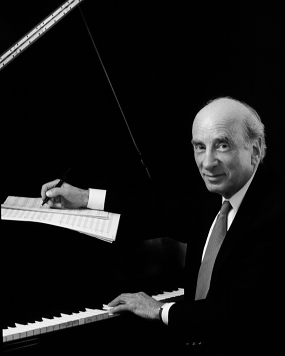 Hyman says he wrote his exuberant, rhythmically tricky, Latin-infused “Danzas Tropicales” first for piano, clarinet, flute, viola, drums and string bass. Later, he created a two-piano version for himself and partner Meral Guneyman, a classically trained pianist.
Hyman says he wrote his exuberant, rhythmically tricky, Latin-infused “Danzas Tropicales” first for piano, clarinet, flute, viola, drums and string bass. Later, he created a two-piano version for himself and partner Meral Guneyman, a classically trained pianist.
Shortly after Hyman met the Dichters through their mutual friend, the late jazz pianist and composer George Shearing, he sent the “Danzas” along. “The rhythms are not easy for people who aren’t into that kind of syncopation, and it requires some serious coordination,” says Hyman, speaking by telephone from Niagara-on-the-Lake in Ontario, where he was performing a concert of ragtime era music.
Misha and Cipa pronounce themselves delighted with the composition. “These were difficult to learn and put together,” says Cipa. “But they are wonderful, really wonderful.”
 The husband and wife duo are pictured performing together once in Dichter’s e-book, but the most famous drawing of the two of them is that of the legendary New York Times caricaturist Al Hirschfeld, who created the image at the Dichters’ request on the occasion of their 30th wedding anniversary. It also adorns their album of Mozart’s piano music for four hands.
The husband and wife duo are pictured performing together once in Dichter’s e-book, but the most famous drawing of the two of them is that of the legendary New York Times caricaturist Al Hirschfeld, who created the image at the Dichters’ request on the occasion of their 30th wedding anniversary. It also adorns their album of Mozart’s piano music for four hands.
“Al did it for us in the ’90s, not so long before his death,” Dichter recalls. Of the pianist’s own cartooning habit, Dichter admits, “I didn’t have the courage to tell him.”
 Dichter says he’s still drawing, and his career seems to deliver up plenty of fodder for caricature, whether it’s a sliding piano on a cruise ship, the desperately declining quality of airline business class, one’s love-hate relationship with piano tuners, or performers’ clever crutches against memory loss.
Dichter says he’s still drawing, and his career seems to deliver up plenty of fodder for caricature, whether it’s a sliding piano on a cruise ship, the desperately declining quality of airline business class, one’s love-hate relationship with piano tuners, or performers’ clever crutches against memory loss.
His current tool of choice, however, is his fingertip on an iPad using Sketchpad Pro, with its arsenal of tools such as varied line thicknesses, fonts and paint buckets. The next book he publishes, if and when he gets around to it, is going to be in vivid color.
Postscript: In the course of researching this story, I was reminded of the following:
In 2006, upon the discovery of Dmitri Shostakovich’s two-piano arrangement of his 13th Symphony (inspired by Yevgeny Yevtushenko’s poem “Babi Yar”) the Dichters had occasion to perform it. They played the first movement together with bass Valentin Peytchinov and a male chorus at the Museum of Jewish Heritage in New York City. This memorial to the Holocaust was a stunning event that began with Yevtushenko himself reading his poem — an unforgettably moving recitation that led directly into the musical performance. For years, the live recorded event was preserved on the museum’s website, but the original path to it apparently broke as the result of an Internet redesign. A helpful Dichter representative has tracked it down, however, and the audio, with Yevtushenko’s recitation, is available here.
Related Links:
- Performance location, date and time: Go to the Ravinia Festival site
- Check out Dichter’s e-book of drawings: Go to RosettaBooks
- More about Misha and Cipa Dichter: Go to the artists’ website
- In 2007, Dichter had an operation on his right hand for Dupuytren’s Contracture: Read about his operation and recovery
Photo captions and credits: Home page and top: A drawing by Misha Dichter of a magic moment in the Brahms Second Piano Concerto, when the cello has a famous solo. “A Pianist’s World in Drawings,” Misha Dichter’s e-book, released this month by RosettaBooks. Misha and Cipa Dichter. (Stefan Cohen) Misha Dichter’s drawings “Altitude Takes Its Toll at the Aspen Festival” and “Intermission at the Aspen Festival.” Composer, pianist and arranger Dick Hyman. Al Hirschfeld drawing of Cipa and Misha Dichter (© 1998 Al Hirschfeld. Drawing reproduced by special arrangement with The Margo Feiden Galleries Ltd., NYC) Misha Dichter’s drawing “Yes We Try To Go On These Music Cruises Every Year.” Below: Misha Dichter’s drawing of a pianist’s hands from above.
Tags: A Pianist's World in Drawings, Al Hirschfeld, Arleen Auger, Aspen Festival, Babi Yar, Chicago Symphony Orchestra, Cipa Dichter, Danzas Tropicales, Dick Hyman, Dupuytren's Contracture, Emerson String Quartet, Josef Krips, Meral Guneyman, Misha Dichter, Ravinia Festival, RosettaBooks, Shostakovich, Yevgeny Yevtushenko


